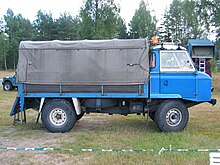Land Rover Forward Control
The Land Rover models Land Rover Forward Control (FWC) were built on the basis of the Land Rover Series II models for military and civil purposes. They were characterized by the fact that the driver's seat, steering and gearbox were moved to the front like a truck to maximize storage space.
From 1962 the first series was marketed as the Land Rover Series II 109 FWC , from 1966 a new series called Series IIB 110 with a wheelbase extended to 110 inches was built based on the Series II-A models . With the end of Series II in 1971, this was discontinued.
From 1975, based on the Range Rover , the 101 models were made for military use; a prototype called Llama for civil use was not pursued.

Many FWC vehicles were only delivered as chassis on which various manufacturers implemented special bodies ; z. For example, the vehicles in the Judge Dredd film are based on an FWC chassis.
As engines normal between 2.25 came liter 4-cylinder and 2.6-liter six-cylinder used.
criticism
The vehicle is often considered to be underpowered given its weight. The braking behavior is negatively influenced by the top-heaviness of the body, especially when the vehicle is empty. The consumption of the vehicles is a minimum of 20 liters, in off-road use it is more than 40 liters, which massively limits the range with the 50 liter tank installed as standard .
The off-road mobility of the vehicle is only given to a limited extent, as the weak engine performance can only be partially compensated for by the enormous ground clearance and the 9.00-16 tires.


